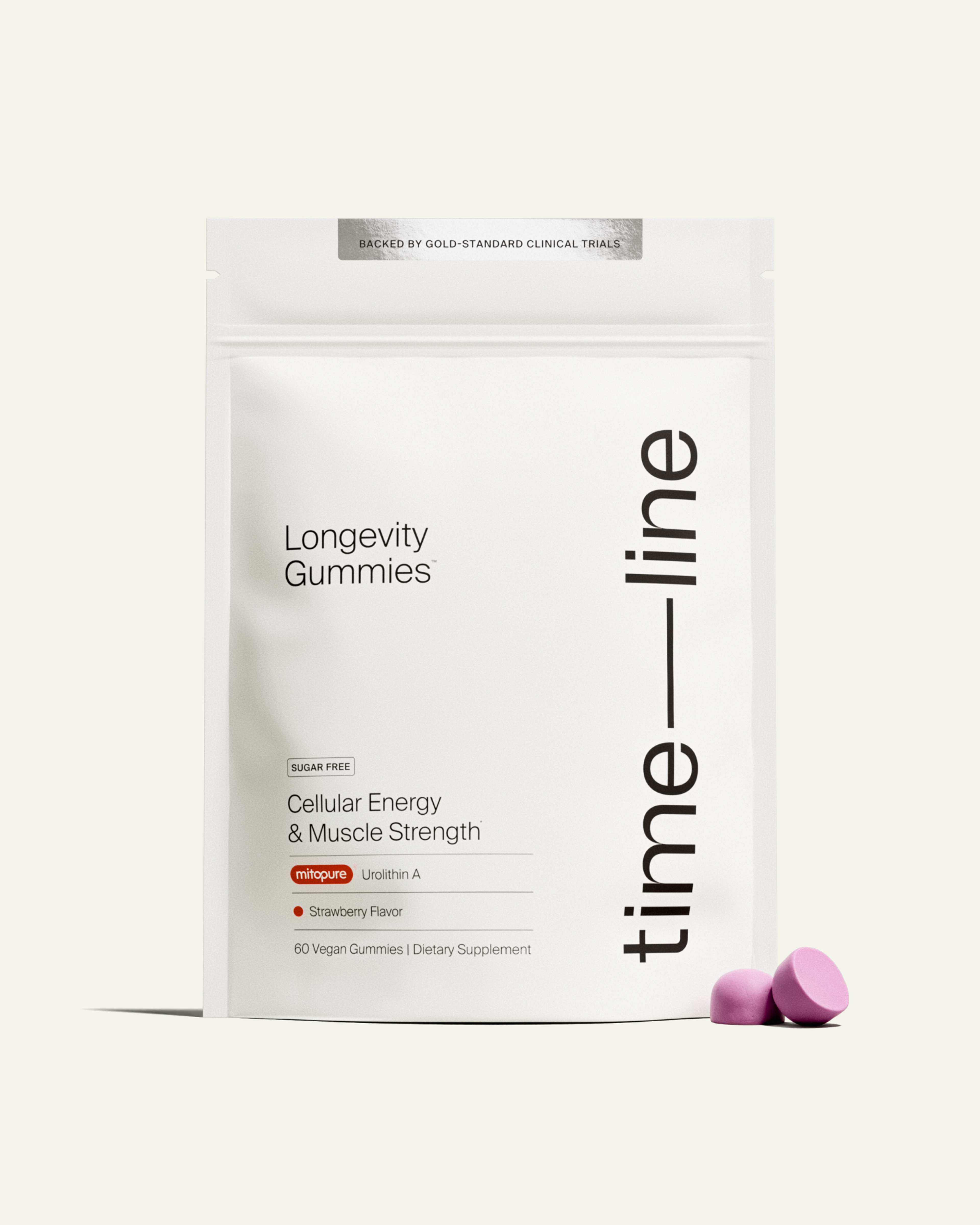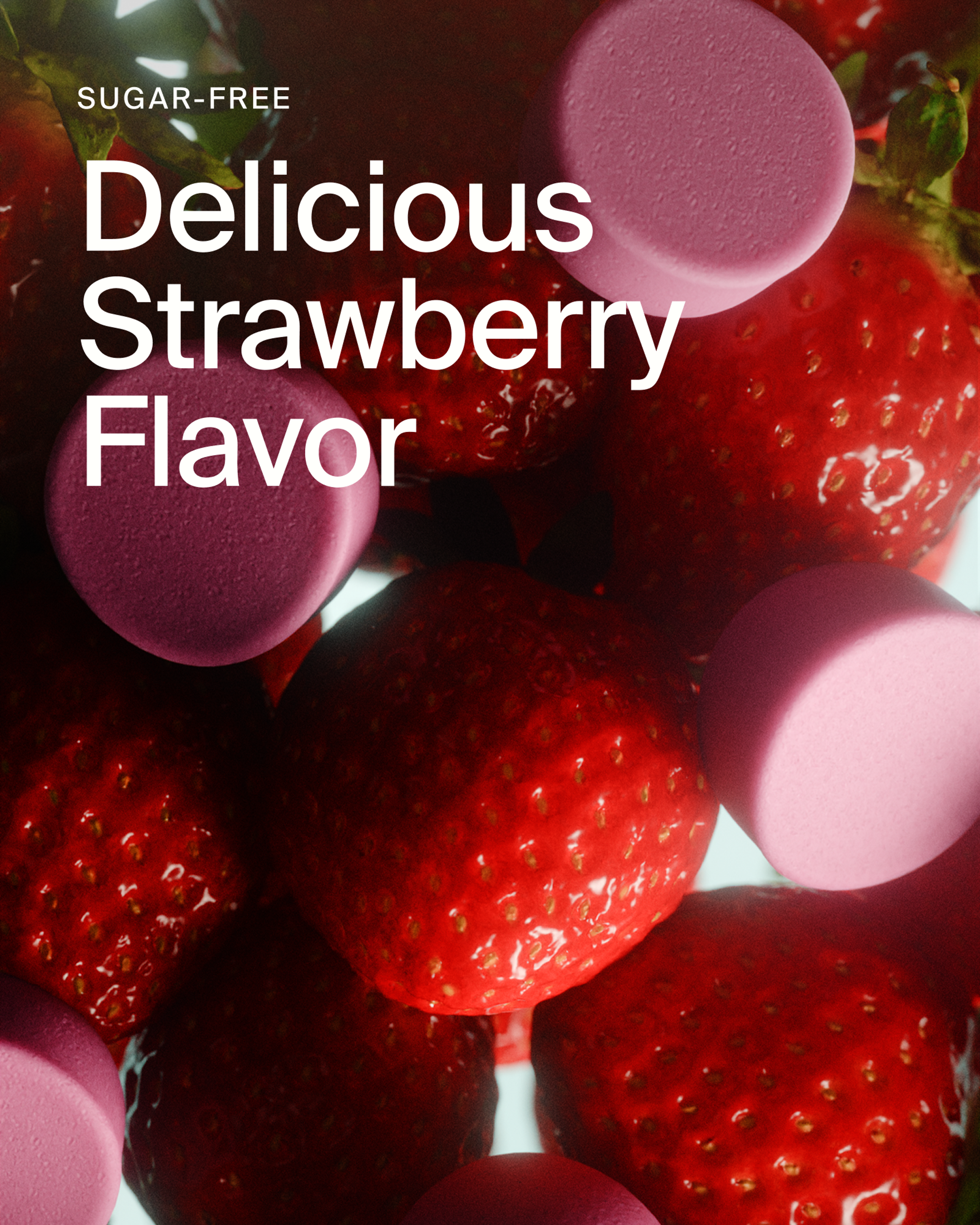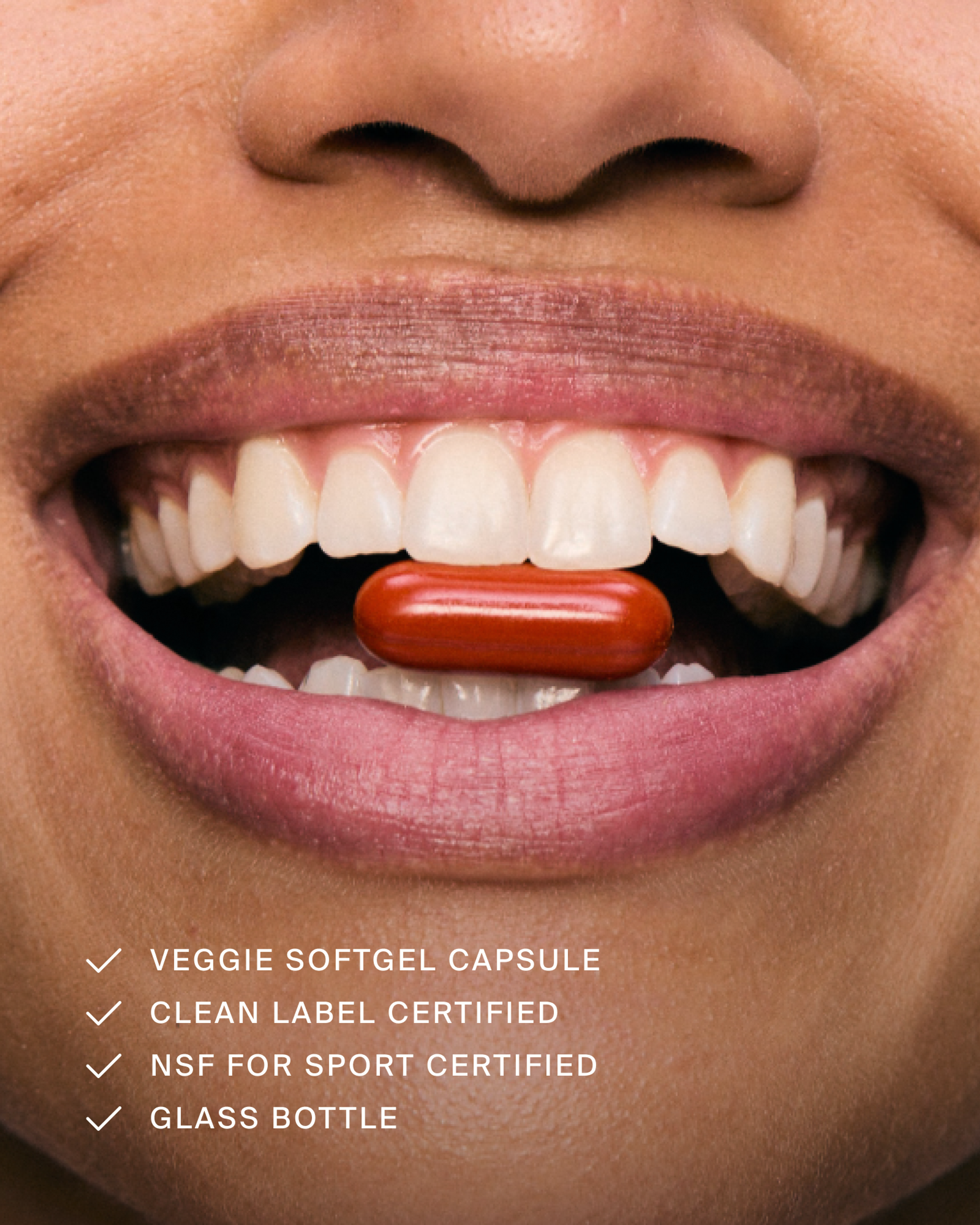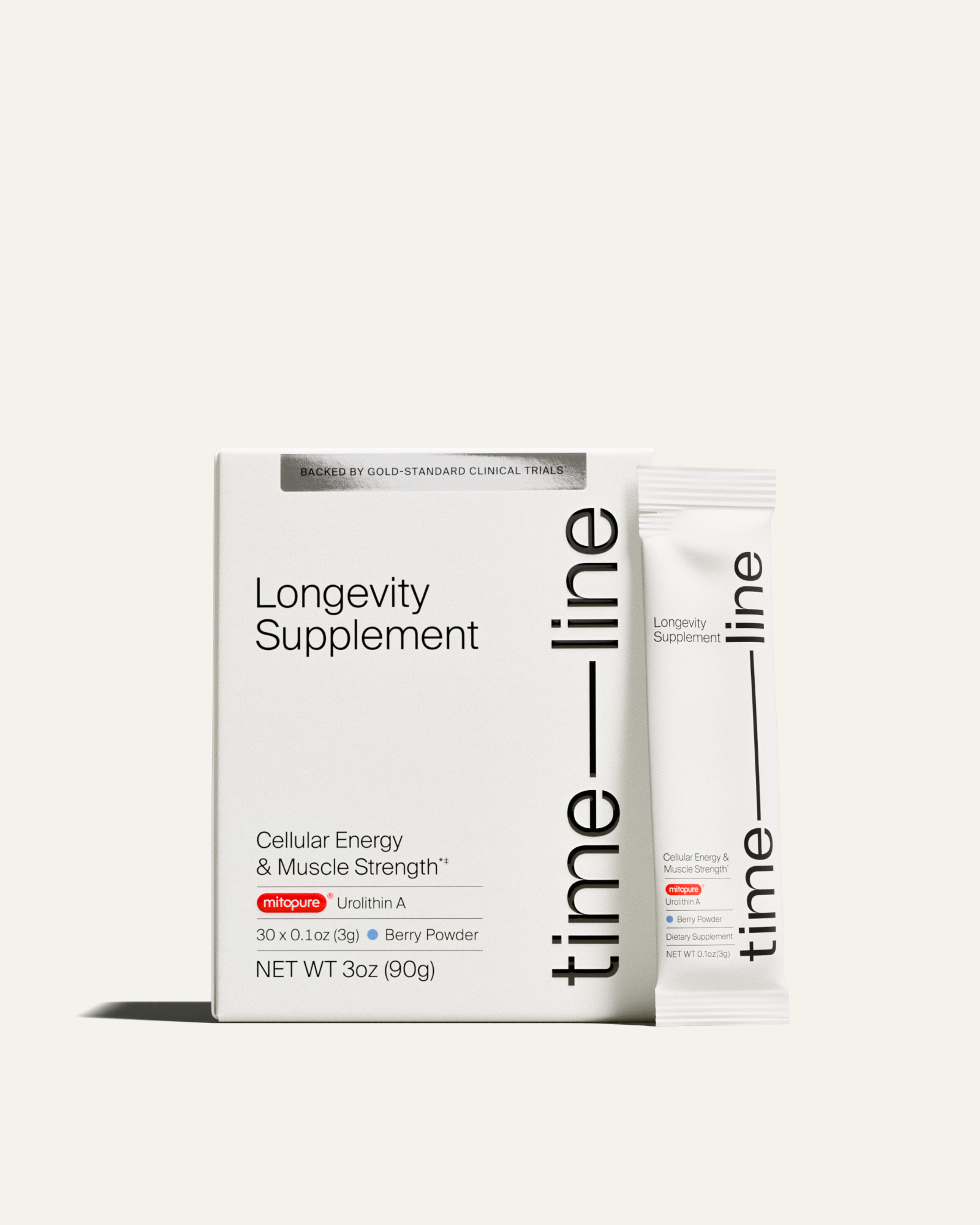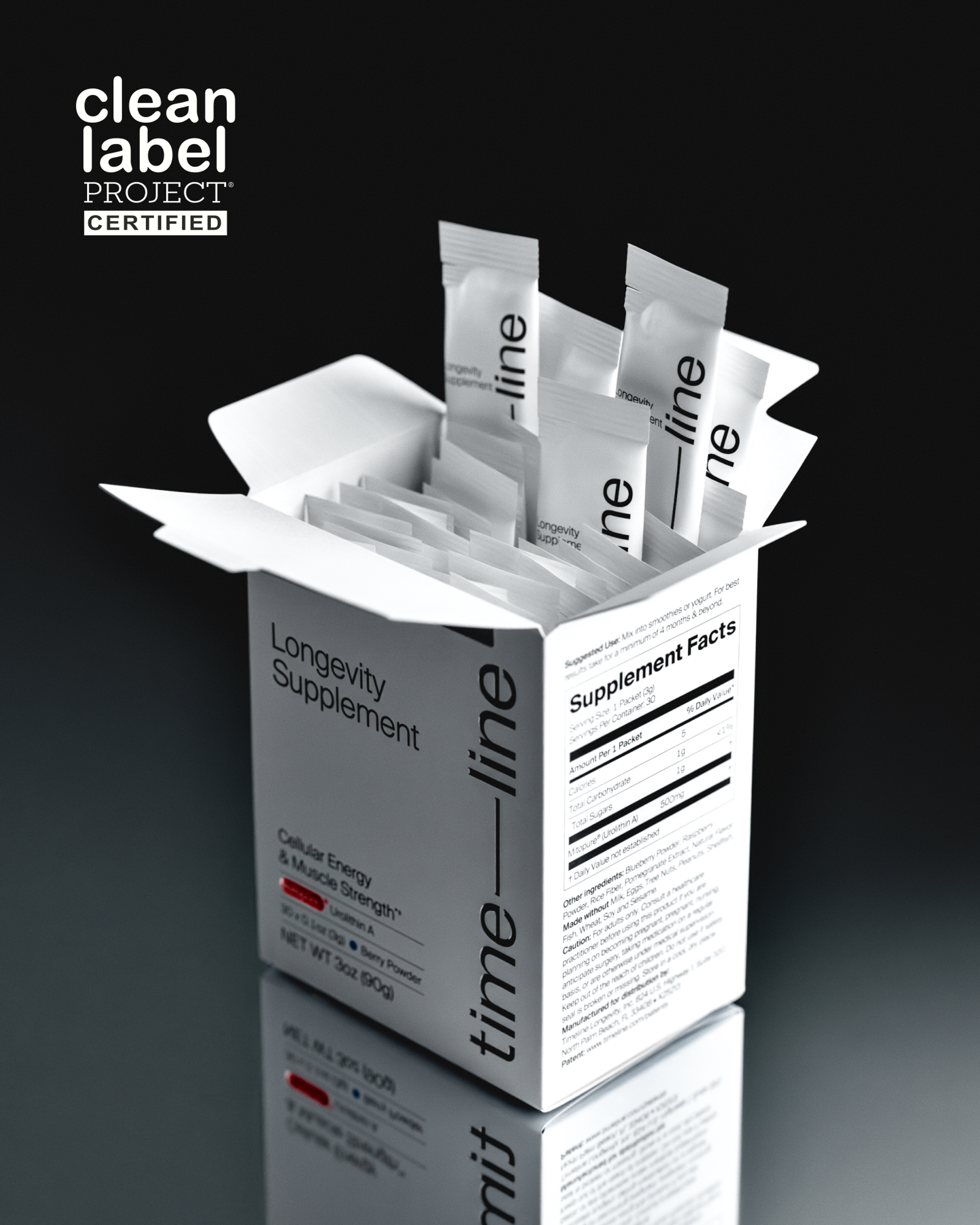Optimizing Mitochondrial Health with Urolithin A
Dr. Anurag Singh joins Dr. Kara Fitzgerald to delve into Urolithin A, a metabolite with vast potential due to its mitochondria-supportive properties.



Podcast
Dr. Kara Fitzgerald | New Frontiers in Functional Medicine, Longevity, Epigenetics
Pomegranates, abundant in polyphenols like ellagitannins, have been widely celebrated for their positive impact on health. Recent research spanning the past decade indicates that a significant portion of these advantages can be attributed to Urolithin A. This compound is a byproduct of gut metabolism, resulting from the transformation of pomegranate's ellagitannin compounds.
Topics covered
- What is Urolithin A, and how it impacts mitochondrial health
- How gut health impacts Urolithin A production
- The published clinical trials and benefits shown with Urolithin A
- How to test if you produce Urolithin A
Transcript
- Dr. Kara Fitzgerald
- Hi, everybody. Welcome to New Frontiers in Functional Medicine, where we are interviewing the best minds in functional medicine and beyond. Of course, today is no exception. I am really excited to be talking with the Chief Medical Officer at Timeline. These are the guys that are doing the incredible science behind as well as the launch of Urolithin A. You're going to learn all about Urolithin A and why you need to, as clinicians or just as savvy consumers, need to be really thinking about this important compound.
- Dr. Kara Fitzgerald
- Before we jump into that, let me tell you a little bit about Dr. Anurag Singh. He is the Chief Medical Officer at Timeline. They're launching Urolithin A. They're also doing skincare products, which I have to say just selfishly, I would love to hear about. These are targeting improvements specifically in mitochondrial and cellular health.
- Dr. Kara Fitzgerald
- Dr. Singh has an MD in internal medicine and a PhD in immunology. His experience includes work at top consumer health companies like Nestle Health Science. Also startup companies, Amazentis and Timeline included. He's authored more than 40 articles for top science journals. He's been awarded over 15 patents.
- Dr. Kara Fitzgerald
- He's designed and led over 50 randomized clinical trials. His research over the past decade across multiple clinical trials on the postbiotic Urolithin A and its benefits has led to the launch of multiple consumer products. Dr. Singh, welcome to New Frontiers.
- Dr. Anurag Singh
- Great pleasure to be on your podcast, Kara. Thanks for having me.
- Dr. Kara Fitzgerald
- Absolutely. I want to know all about Urolithin A, and we need to know what it is and how we make it in our bodies, and why it's important, and fold that into the backstory. It's a compound that was discovered 40 years ago, and then you guys have just really gone deep into the science. How did this become of interest to you?
- Dr. Anurag Singh
- As you correctly pointed out, the discovery of Urolithin A or the origins have been known in human... When they started looking at some of the consumption around nuts and berries, for a long time, for almost 30, 40 years, the Spanish group has been studying how it relates to gut microflora and things like this.
- Dr. Anurag Singh
- About 15 years back, which is when we started the company behind all the research, and Amazentis, which is the parent company behind all that research that goes into Timeline products, the goal was to apply the biotech approach to nutrition. A lot of us come from backgrounds in nutrition research for a number of decades.
- Dr. Anurag Singh
- We felt that there was a lot of background around blending extracts and prebiotics and probiotics with minimalist science. What we started looking was exactly what some of these fruits and berries and nuts had beneficial compounds in them.
- Dr. Anurag Singh
- One that really attracted our interest was the pomegranate. There had already been a lot of studies done on pomegranate juice and some of the health benefits associated with it. We went around the world basically sourcing pomegranates from different geographies and started looking at different juices from different pomegranate source.
- Dr. Anurag Singh
- Every time we ran experiments, a pomegranate itself has about 500 beneficial compounds. These are mostly polyphenolic compounds that we call as ellagitannins and punicalagins.
- Dr. Anurag Singh
- When we were doing these experiments, we started working actually at the Swiss Institute of Technology with a professor called Professor Johan Auwerx, who is a big name in the mitochondrial field. He was behind the discoveries of respiratory and a lot of NAD boosters.
- Dr. Anurag Singh
- We gave him these compounds. We didn't know which one was behind the beneficial effects. He came running to our lab and he said, "What is this one compound? It's really boosting the longevity in worms," because worms is where all the aging research starts.
- Dr. Anurag Singh
- That's the origin 15 years back. We were mostly interested in the polyphenols early on, as I mentioned, the ellagitannins and punicalagins. Then somehow every direction we looked, all roads led to Urolithin A, which is this gut metabolite that is derived from these precursors being the ellagitannins and punicalagins.
- Dr. Kara Fitzgerald
- Except we don't all make Urolithin A either at all or certainly in appreciable amounts. I know there's a phenotype for who's producing what. We're not all going to… If we can eat a pomegranate a day... Or in the case of my colleague at my clinic, he actually eats the white, he doesn't eat the seeds, trying to avoid the sugar from the seeds. But we can all eat this and we're not going to make this amazing Urolithin A, correct?
- Dr. Anurag Singh
- Yes, absolutely correct. We have done a number of studies, different populations in France and Canada, in the US, and obviously the percentages differ depending on... Probably people in France and Italy are eating more fibers and berries and nuts, all in close to the Mediterranean diet, we see about 30, 40%. In the US and other North American countries like Canada, we see a very low percentage. We see even 10, 15% people who have the ability, and it's very variable.
- Dr. Anurag Singh
- I'm also one of them. I grew up in India, where antibiotic use is very common. I'm guessing growing up, I was given so much antibiotics that all my gut microbiome, basically the beneficial side just went away. I can actually drink six glasses of juice and my body won't make even an iota of this compound, so I actually need to supplement it.
- Dr. Kara Fitzgerald
- That's so fascinating to me. That could be one of the causes, exposure to antibiotics, which is obviously heavy in the States and in Canada, but also the diet. Just generations of exposure to a Mediterranean-type diet would yield the production of the bugs that could actually make that. But even there, you're still not seeing the majority of them. I think you said you-
- Dr. Anurag Singh
- We've actually taken a deep dive. We've actually taken people who produce very high. When I say high, almost equivalent to what a dietary supplementation would get you, and this is about less than 5% of the people. Then we have those if you actually gave them the right diet. If you actually gave them the fruits and the pomegranate juice, the precursors and you expose them for a while, and their bodies will start producing it.
- Dr. Anurag Singh
- They have the gut microbiome. It's just that they're not eating right probably regularly. That is about 30, 40%. Even the variability of response, so some will make what I call as subtherapeutic or sub-health benefit range where you're not going to get any beneficial effects.
- Dr. Anurag Singh
- Then there are those people who you can give lots of fruits and nuts, but their bodies will never convert. The answer is really the gut microbiome. We've looked at the gut microbiome of these different phenotypes, and the answer is the richer and the more diverse the gut microbiome, the better chance you have to make this molecule.
- Dr. Kara Fitzgerald
- Coming from whole foods, I'm a proponent obviously of a whole foods diet, functional lens, clearly we want to move everybody on to this rich diet, but then also respect that we may never make therapeutic amounts, so there's a place for supplementation. I know that my listeners are wondering whether or not you've been able to nail down the specific microbes that act on the ellagitannins and produce Urolithin A?
- Dr. Anurag Singh
- It was certainly a project that I co-led internally along and towards this project. The answer is we are no closer than we were before, let's say, five years back in our research lifecycle. The answer is primarily, no, we are not close because the gut microbiome is a very complex ecosystem. It would be that we would think we have the answer with one particular gut species. The next time we would repeat the experiment, another species would become the dominant species.
- Dr. Anurag Singh
- I think it's really the whole ecosystem. There may be certain... We do what is called as gut microbiome sequencing of the people who are really high producers. We do see certain beneficial gut microbiome profile. It's high in akkermansia. These people have a lot of high akkermansia. They're eating a lot of good fiber and they're eating the right foods and nuts, which is why now the gut microbiome is evolved to producing Urolithin A. Now, is akkermansia the key strain needed to convert? We don't have an answer yet.
- Dr. Kara Fitzgerald
- Isn't that fascinating? Yeah, akkermansia shows up everywhere. It's just something that you want in robust quantities. That's interesting. Okay, I was going to try to pin you down to see if you had anything. I'm not even going to go there. I know that you've spent a lot of energy trying to identify it, but it's a whole nice, rich collection of microbes. We see akkermansia present in abundance in healthy centenarians, and it's probably associated with a robust microbiome, but also a lifestyle commensurate to enabling that.
- Dr. Anurag Singh
- There's now reason to believe that if you continued following a healthy lifestyle that you could recondition your gut microbiome back to how it should have been. I'm sure you can achieve that. It's really a question of would you still get enough of the phytonutrients that a lot of these gut microbiome species are making what we will call, and we will discuss that as postbiotics.
- Dr. Kara Fitzgerald
- In therapeutic amounts and enough to actually yield a difference. This is what you guys have done with Urolithin A and making this bio-identical postbiotic product. I want to start to talk about it. I know there's been a lot of clinical research in muscle health, but there's other Urolithins. Any comments on those, Urolithin B? I know that you guys lighted on Urolithin A as the powerful player, but I'm just curious about the other family of Urolithins.
- Dr. Anurag Singh
- There are four major families, Urolithin A, B, C, D, and we have studied all of them. In fact, back to our first paper in Nature Medicine, we actually phenotyped all of them. Urolithin A basically had the best effects. I'm not saying that other Urolithins didn't have smaller effects in those.
- Dr. Anurag Singh
- We chose to move forward because even in our studies where we actually did these gut microbiome analysis and trying to look at the percentage of people who make it, turns out that really, Urolithin A is the major phenotype.
- Dr. Anurag Singh
- A lot of folks actually, if they were to make Urolithins, they would make Urolithin A. That made sense from first trying to develop all the research behind on Urolithin A, albeit there's a lot of emerging research on Urolithin B, which is the other main phenotype associated found commonly in humans.
- Dr. Kara Fitzgerald
- We can move into muscle health. That's extremely interesting. Where do you want to start? I'm curious to unfold your journey, like some of the preclinical findings and then maybe what led you into seeing being a miracle player for mitochondrial health and muscle support is right there.
- Dr. Anurag Singh
- As I mentioned, we started collaborating with the laboratory of Professor Johan Auwerx, who's really one of the big names in the mitochondrial field. We started working with him because of the anecdote story I told you about where he started testing in worms now. That's where most of the aging research started or starts.
- Dr. Anurag Singh
- In these experiments, what Johan was seeing was basically a lifespan extension of about 40%-50%, which is pretty high. For example, if you look at all the respiratory trial literature, which is another compound known to boost mitochondrial health in these lifespan experiments in worms is about 20%.
- Dr. Anurag Singh
- That's what all the initial research started with. Then Johan started playing with looking at what were the pathways being impacted in mitochondria. He started comparing things like calorie restriction or fasting, which is also known to upregulate things like autophagy and mitophagy and mitochondria, which is basically the cleaning of the cellular debris. Then he started comparing them to Urolithin A and the effects were pretty similar. That's the research.
- Dr. Kara Fitzgerald
- Let me just restate that. We'll come back and talk a little more about mitophagy, but basically it was comparative with caloric restriction, which is something that humans are not... We're just not going to succeed at until we need these caloric restriction mimetics to yield some of the benefits.
- Dr. Anurag Singh
- Totally agree. Compliance would be very poor in the clinical translation of some of these caloric restriction regimens. From there, we started, of course, in older animals and looking at how it affects on endurance and running capacity and muscle health, which primarily seemed to be the big phenotype emerging in these experiments. When Johan started supplementing in the diet of these older animals, he started seeing about a 60% improvement in aerobic endurance, about a 10% in muscle strength, for example. That's what really led to all the clinical research down the road that we have done over the past 7, 8 years.
- Dr. Kara Fitzgerald
- Just really cool. Let's just talk a little bit about hallmarks of aging, mitochondrial dysfunction, and mitophagy. Then I definitely want to get into the human-
- Dr. Anurag Singh
- Yeah, sure. Absolutely, we'll get into that. Today where we see ourselves, and that's part of the journey of Timeline has been, we see ourselves with a mission that we want to increase the health span of people. If you can do targeted supplementation, people who can derive the benefits from this targeted supplementation can then live to 80, 90, but be more functional. That is our philosophy.
- Dr. Anurag Singh
- When we started out, we didn't know this compound was going to hit mitochondrial health or mitophagy. About 10 years back, just when we were discovering Urolithin A, this landmark publication from Guido Kroemer came out called The Nine Hallmarks of Aging, which basically describe what happens biologically with aging.
- Dr. Anurag Singh
- You have these genetic alterations, so your DNA becomes a bit more unstable. You have all these epigenetic modifications that happen. Then you have things like decreased nutrient sensing and increase in protein aggregates that lead to, for example, diseases like Alzheimer's disease.
- Dr. Anurag Singh
- One of the key findings in that hallmark that you found, or Guido suggested, was that they all somehow linked to mitochondrial dysfunction. That's what got us into mitochondrial dysfunction. [inaudible 00:16:36] now they have revised these after 10 years, these hallmarks of aging, and the three additional hallmarks are gut-gut dysbiosis.
- Dr. Anurag Singh
- As we age, our gut microbiome changes. The second new one is declining mitophagy and autophagy, which is what really we're going to talk about during the rest of the podcast. Then the third is chronic inflammation. The mitochondria seems to be the central pillar that connects all these different hallmarks of aging. I think the data we are seeing today with all the clinical studies suggests that this postbiotic Urolithin A is doing similar things, decreasing inflammation, improving mitophagy, improving mitochondrial health. That's the story with hallmarks of aging.
- Dr. Kara Fitzgerald
- It's so exciting. It's really interesting. I published a study and I'm continuing to research looking at biological age and a diet and lifestyle intervention. I'm definitely interested in seeing what Urolithin A is doing in the mix. Hopefully you'll be looking at epigenetics. Is that in the works?
- Dr. Anurag Singh
- It's in the works. We have actually first developed a test now that can tell you if you are a Urolithin A producer or not. We're starting there. It's a simple test. With the skin as a blood lancet, prick on your finger, you just drop a few drops of blood, and we can tell you if your microbiome is conducive to making Urolithin A. Then down the road, we do see adding things like biological age to the mix where consumers can take a look at how regular supplementation can impact some of these biomarkers.
- Dr. Kara Fitzgerald
- Talk to me about Urolithin A in the clinical studies.
- Dr. Anurag Singh
- The first studies we tried to translate, giving from the work that was published, all the preclinical work from Johan Auwerx lab, the first thing we wanted to do was show, of course, the safety and bioavailability in older adults, which at that time was really the target population when we wanted to make older and the aging population function better.
- Dr. Anurag Singh
- The first things we did was, we actually took a cohort of older people who were extremely active and then a cohort of people who were what we call as frail or very sedentary, so they weren't moving around. We looked at their mitochondrial health. The way you do that is by taking a small chunk of muscle tissue from the leg through a procedure called as muscle biopsy.
- Dr. Anurag Singh
- When we looked at these two populations, what we saw was that basically the mitochondria were really the key declining factor in the skeletal muscle of these older folks who weren't moving around. Then we took these older folks who weren't moving around and we supplemented them with different doses of Urolithin A. Starting at about 500 milligrams to topping to about a gram, we really started seeing about four weeks of supplementation improving mitochondrial health in the skeletal muscle of these older adults who were very sedentary, who were very prefrail. That's how it all started.
- Dr. Anurag Singh
- Since then, we have done many more randomized clinical trials, much longer than four weeks. We've done up to four months. We have gone from older adults, which was the trial that we repeated after this first one that got published in Nature Metabolism. We showed that giving it for four months, we improved in older adults, who are, again, not moving around too much, we improved their fatigue levels, so people were moving around much more and they were getting less fatigued as they did exercise.
- Dr. Anurag Singh
- Then we went and did a trial even in the younger middle-aged, 40-60-year-olds who were also sedentary and not moving around. We saw similar effects of improving strength and endurance. That's essentially the data, that is all the published, but we have a number of studies going on.
- Dr. Kara Fitzgerald
- You looked at CRP too, right?
- Dr. Anurag Singh
- We did, yeah.
- Dr. Kara Fitzgerald
- Go ahead.
- Dr. Anurag Singh
- Again, these studies take time. These randomized trials take over a year, and then you collect plasma, you collect muscle biopsies, and of course, you do all the functional readouts. I'm trained as an immunologist, and it has always fascinated me how the mitochondria could be playing a role in inflammation as well by improving mitochondrial health.
- Dr. Anurag Singh
- We started looking at CRP as a marker of chronic inflammation, because a lot of older adults are chronically inflamed. A lot of overweight and middle-aged people are inflamed as well. In all these trials, one biomarker that seems to be significantly impacted is CRP, which is always up in these trial populations we test. I think future research needs to really look at the close talk of mitochondrial health and immune health as well in inflammation.
- Dr. Kara Fitzgerald
- Absolutely. Yeah, I would be I'd be really curious to see the other biomarkers of immune health and even lipids. You could probably cast a wide net. Thoughts on that?
- Dr. Anurag Singh
- Yeah, we did cast a wide net, and there are two set of biomarkers that move a lot. CRP is one of them, and there are certain cytokines like interleukin 6, which is another very pro-inflammatory cytokine linking to the similar cascade with CRP. Then the other set of biomarkers we see moving a lot is linked to fatty acid oxidation. This is really what we call as acylcarnitines. In diabetics or in obese people, acylcarnitines are very high, because the body is not able to utilize fuel. The cells are not able to utilize fuel properly and fat impairs. What we see is now a very decline in these levels and a much better utilization of acylcarnitines in these biomarkers.
- Dr. Kara Fitzgerald
- That's really exciting. I will admit that I'm quite bullish on Urolithin A. Again, I'm just a huge fan of polyphenols. I'm a huge fan of the wonderment of the microbiome and what it can do. But I also appreciate that many of us, especially those of us growing up in the west or exposed to antibiotics, don't do a good job.
- Dr. Kara Fitzgerald
- I'm currently taking Urolithin A. I'm here in Mexico, so I wasn't able to do the baseline test that you described. Maybe we should swing back to that to just let clinicians and regular people who are interested just know how to do that and access it. But I'm pretty excited about the possibility of it. I think that as you get into looking at DNA methylation, and epigenetics, we're going to get a whole other database of information on the wonderment of this compound.
- Dr. Kara Fitzgerald
- I know my limited investigation shows that it influences histone deacetylases and microRNAs and stuff like that. But am I an appropriate candidate to take it? Are you taking? Who's the right person to be... Beyond obese and older folks. It seems like we all might consider using Urolithin A if we're not producing it or not producing it in therapeutic amounts. What do you think?
- Dr. Anurag Singh
- Yeah, sure. Well, I'm taking it. I'm a mid-40-year weekend warrior. Not super active every day, but yes, in the weekends, definitely. I think the original clinical studies were designed in populations to give it the highest chance of success that had underlying mitochondrial dysfunction assumption. Since then, since our launch, what we see is that even top athletes are on it. A lot of people who are amateur athletes or weekend warriors, just like I described myself, they are on it and they swear by it because it hits on things like... As I mentioned, with exercise, CRP goes up, and mitochondria also get damaged with regular exercise.
- Dr. Anurag Singh
- That's a very emerging stream of research that we are actually also pursuing in elite athletes, trying to show that muscle recovery is better. Things like creatine kinase could be blunted or muscle damage could be blunted. I think it's something that people need to start taking in their adult years, because muscle strength basically starts to decline 10% every decade following your third decade. I think you need to be proactive and address how to address both muscle and cellular health pretty much upfront, rather than wait for the symptoms to appear, much like our modern medicine is.
- Dr. Kara Fitzgerald
- Yeah, I appreciate that thinking. Well, let me just ask you this. You're probably aware of some of the studies looking at athletes using antioxidants and actually kicking in insulin resistance, like a negative effect. The hormesis of exercise was blunted by introducing antioxidants in athletes. Would you have any evidence of that with Urolithin A?
- Dr. Anurag Singh
- Urolithin A, we don't see it having a robust antioxidant effect. It's really a mitophagy activator. What it is basically, again, to summarize what mitophagy is, is basically it accelerates the cellular garbage disposal machinery inside our cells. With exercise or with aging... This is well-known in even elite athletes that they have mitophagy that is blunted. If you track an athlete over time in just a year or a season of performance, they always decline.
- Dr. Anurag Singh
- Actually, a lot of researchers in this field came to us. Louise Burke in Australia at ACU, she has looked in elite athletes doing most of these studies that you were mentioning. She said, well, one thing that we start to see in these elite athletes is blunted mitophagy. We think Urolithin A has a chance to show something in this population, because what we are looking always is trying to get all the mitochondrial and muscle repair happen pretty quickly in these athletes. Again, research is going on, but there are several elite athletes today. There are several Tour de France teams that swear by it and that are on it, anecdotally. But yes, the research will soon come out.
- Dr. Kara Fitzgerald
- Good. Okay, so we'll pay attention to it. Everybody, when you go to the show notes, of course, you'll see links to the websites. You've been in the center of researching, of studying it. There's a ton of citations there, but you're also paying attention to other people's work as well. As these clinical trials from elsewhere come up, I think you'll be probably posting them on your site, right?
- Dr. Anurag Singh
- Yeah, it's amazing. When we started, gosh, 15 years back, we were probably the only group studying Urolithin A and its beneficial effects. Today, there are a number of groups. The National Institute of Health and National Institute of Aging is investing millions of dollars into looking at urolitin A's effect, just not on cellular health and muscle health, which basically a lot of research has been done on it. They're looking at neurodegeneration.
- Dr. Anurag Singh
- There are a lot of top research groups who have studied it, and they think that a lot of problems with aging and cognitive health are down to declining cellular and decline in mitophagy, and this is where they have been. I expect a lot of trials done by others and different health benefit areas start to pop up.
- Dr. Kara Fitzgerald
- That's very exciting. It's really cool. One of the reasons I was looking forward to chatting with you is I appreciate companies who invest this kind of time and dollars in really drilling down. There's very few in the nutrition space who make this commitment to the science, to the preclinical as well as the clinical science. It's just a real pleasure and really an honor for me to be able to highlight the efforts that you've made.
- Dr. Anurag Singh
- That's always been, as they say, the North Star for us. It's a company founded by doctors and scientists. As I mentioned, we studied this compound for 15 years until we decided that we believed in it enough to start selling it so others can have health benefit.
- Dr. Kara Fitzgerald
- You guys uniquely figured out a way to make a bio-identical Urolithin A, and that's what... I'm sure that, well, at least a few of your patents are related to figuring out how to do that.
- Dr. Anurag Singh
- Yeah, indeed. I guess we have looked at a lot of health benefits, and muscle health just shone out loud because of all the experiments and the research that went behind it. We pretty much believe in the science and we have the right intellectual property around it to go and commercialize it, which is what you need to do.
- Dr. Kara Fitzgerald
- Let's talk about dosing. This is something that we want to be considering in all adults for the reasons that you've mentioned, and you've done different dosing studies. What do you take? What do you recommend?
- Dr. Anurag Singh
- Yeah. A lot of muscle specific health benefits start showing up at a dose of 500 milligram, so that's the dose we have studied a lot in clinical studies. We have gone higher and lower. Lower doses do affect certain biological pathways, but maybe you need to take them just longer to see physiological benefits.
- Dr. Anurag Singh
- The dose that I think has the best clinical data is a gram of Urolithin A, and this is where we start seeing even things like VO₂ max, which improved by 10%, which is... Basically if you look at all the clinical studies on muscle and physical performance, it's equivalent to about 4-6 months of regular exercise, you would get 10% increases. That's the dose that excites me personally a lot, and I take it. But you can get a lot of health benefits and strengthen other measures, such as improved cellular health, with 500 milligrams.
- Dr. Kara Fitzgerald
- Very exciting. Any side effects that you've come across?
- Dr. Anurag Singh
- We have done, gosh, what, about 1,000 participants in our clinical studies and now thousands of customers. I think there is no [inaudible 00:31:37] for your consumers. There's no upper limit of adverse effects. Our dossier for safety was studied even by the FDA, and they agreed with it that you can take it even much higher than we are taking. It's just that if you go even higher than a gram, you saturate the bioavailability. You can just keep going and expecting higher and higher as the body has ways to absorb different nutrients.
- Dr. Anurag Singh
- This is a natural compound that has been around evolutionary, produced in our bodies, and so that's what makes it so safe. We haven't really seen any side effects that link directly to the product so far.
- Dr. Kara Fitzgerald
- Good. Yeah, that makes sense to me. It's nice to know that you've identified an upper limit where you saturate, and so there's no, "some is good, more is even better." There would be no utility in taking more. You've talked about some of the other studies going on. Anything to add to that? Other human studies that we want to be paying attention to?
- Dr. Anurag Singh
- Yeah. We have a few ongoing studies. One that is just wrapping up, as I mentioned, is the study with elite athletes and looking at muscle recovery should be out this year. We've just launched another study with Professor Stuart Phillips at McMaster, who has done basically a lot of high protein and anabolic resistance with aging research. He believes that problem often seen with high protein supplementation with aging is that the body cellular machinery is not able to take in the excess protein. He thinks by improving the bioenergetics, you can basically amplify the effects of high protein supplementation.
- Dr. Anurag Singh
- That's a study ongoing in immobilized population where you put a knee brace in healthy people and their muscle starts to waste, and then you supplement with high protein and Urolithin A, and you see the impact on muscle recovery. Then we have a very growing axis of research on immune health and skin health. These are the two other research areas we have.
- Dr. Anurag Singh
- Immune health, mostly research done by academics who came to us showing that they were boosting the stemness of immune cells. Typically in cancer patients going chemo radio, the immune system basically goes to zero after a new adjuvant therapy. How fast the immune system can recede basically dictates a lot of outcomes post-cancer recovery.
- Dr. Anurag Singh
- They showed us this data, which we are now translating, that taking Urolithin A post-cancer can accelerate immune health mostly by boosting mitochondrial health. Then the skin aging is basically topical application, and a lot of research is ongoing on that, how it can delay, in addition, that mitochondria play a key role in skin aging, and by acting on that, you can boost things like lowering wrinkles, et cetera.
- Dr. Kara Fitzgerald
- Is that a commercially available product? I must get [crosstalk 00:34:49].
- Dr. Anurag Singh
- It was commercially launched just this week, so this is-
- Dr. Kara Fitzgerald
- Really?
- Dr. Anurag Singh
- Yeah. We're writing the publications up, so hopefully you'll see them out pretty soon. But we've spent a good part of the last couple of years looking at the effects on skin, and the effects are similar to muscle. You operate late mitophagy in aged skin cells, you lower inflammation, and that results in basically an impact on both intrinsic and extrinsic skin aging. Yeah, these products are launched on our website just this week.
- Dr. Kara Fitzgerald
- That's really cool. This is topical delivery?
- Dr. Anurag Singh
- This is topical delivery, yeah, instead of oral.
- Dr. Kara Fitzgerald
- Have you seen similar with oral delivery on skin, or does it need to be delivered topically?
- Dr. Anurag Singh
- It's an idea that has been fermenting to look at the... Some certain consumers anecdotally have come back to us after months of using the oral and talked about how their skin is looking better, and so this is something we plan to do. Topical made sense, because you're acting directly at the organ of interest, which is the skin, and then now we will combine it or run some trials in combination.
- Dr. Kara Fitzgerald
- That's very interesting. Let's just talk about clinicians, where we're going to direct them, and just regular people interested in accessing the product. Doing the test that you talked about, do you want to talk a little bit about that test and then just guide us on our next steps?
- Dr. Anurag Singh
- Yeah, sure. Well, I'm a clinician myself, and I think anybody who comes to your clinic with declining energy levels or feeling more fatigued... People who typically come to you and say, "Hey, I used to exercise this much and not feel it, but now it takes me much longer to recover." I think those are perfect candidates in the clinical realm, of course, older adults with functional impairments and overweight. Sedentary population, again, fits the bill.
- Dr. Anurag Singh
- The test is a great tool to know whether in the practice and functional practice area, whether in the dosing, you need to supplement it, because you could tighter even the dosing based on the levels that you get from the diet. We've invented a test. It came from the experience I talked about when I saw that my body wasn't making...
- Dr. Anurag Singh
- After drinking six glasses of pomegranate juice, I said, "Hey, let's invent a test." It's a very simple test. A test is basically a health kit that you get. It's still in prototype trialing. It's in part of a clinical study. Comes with what we call as a dry blood spot filter card. You basically prick your finger, put a few drops of blood as a first part of the test.
- Dr. Anurag Singh
- You can drink also a glass of pomegranate juice before that to just make sure you're giving yourself the best chance to see if your body will convert, or you can do it in real life, just if you think you're eating already a good diet. That's your baseline setup. Then the kit comes with one serving of our product that gives you 500 milligrams of Urolithin A or Mitopure. Then you do the same. You again do a second blood prick test in the spot and you send it to our lab, and you get a very nice report showing you the baseline levels or with the juice versus after taking the supplementation.
- Dr. Anurag Singh
- I think it's a cool test to implement in the clinic where doctors can already see which individual absolutely needs the supplementation. Then if you're making a little bit of it, then start off at 500 dose. If your body is not making anything and you are severely functionally impaired, then you maybe want to start at a higher dose.
- Dr. Kara Fitzgerald
- With the upper limit being 1,000, no benefit after that?
- Dr. Anurag Singh
- Yeah, so far. We have studied two grams and we haven't seen anything.
- Dr. Kara Fitzgerald
- [inaudible 00:39:04] peds? Any indication in kids for this?
- Dr. Anurag Singh
- No, we haven't studied it in peds yet. We have done some work in lactating mothers just to see if it crosses into the breast milk, and it does. We do see, again, similar, like 30% mothers can convert, and that can be detected in the breast milk of them, so that means that the offspring is being exposed to it, but we haven't done any safety work or any efficacy work in the pediatric population.
- Dr. Kara Fitzgerald
- Well, lots of research to come, but it sounds like the scientific community is paying attention.
- Dr. Anurag Singh
- It's paying a lot of attention, yeah. This last year, there were over 100 publications on Urolithin A, and when we started out, there was zero. So yeah, it's growing.
- Dr. Kara Fitzgerald
- Well, Dr. Singh, it was really great to talk to you. Let me just give you a minute if there's anything else that you want to add.
- Dr. Anurag Singh
- Well, I think the way I see it... And it's not because I was involved with the discovery and the research. I see good health as three pillars. One being exercise. You have to exercise regularly to improve your mitochondrial health, and that's well-known. The second pillar is good nutrition, good diet. You need to be taking your fruits and nuts and getting enough fiber to give your gut microbiome the chance to derive the phytonutrients.
- Dr. Anurag Singh
- But I think more and more that the third pillar that will really support these first two pillars of good exercise and good diet is adding certain phytoactives and phytonutrients that will boost your cellular health and that will have long-term implications on how you will be when you're 80, 85. That's where I think our story and the story with the Urolithin A really fits very nicely.
- Dr. Kara Fitzgerald
- I love it. Yes. Lots of papers, lots of goodies in our show notes, folks. I know there's actually a deal that Timeline is making available to clinicians listening to this show, to people listening to this show. Everything will be packed into the show notes, and then we'll link over to the research to Timeline website. The product names might appear, this Urolithin A, so just head over to the site and you'll find everything that you're looking for, everything that we've discussed today.
- Dr. Kara Fitzgerald
- Dr. Singh, it's just really been a pleasure to talk to you. I look forward to talking to you again as this science emerges. I'm sure at the end of 2023, there's going to be a whole lot more.
- Dr. Anurag Singh
- Sure. No, same here. It was a pleasure talking to you, Karen. I look forward to talking about the future research.
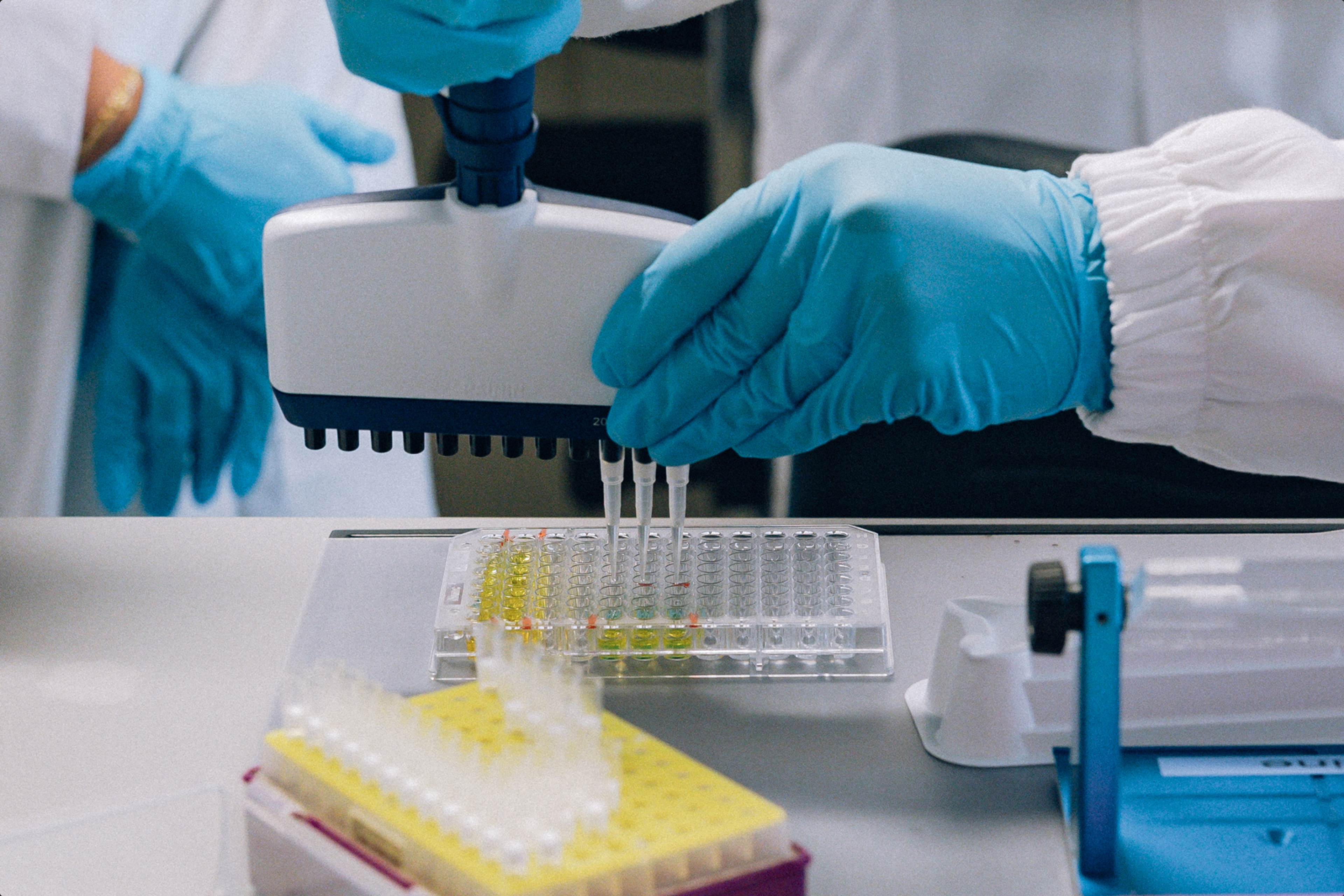
·
Nutrition·
Studies·
